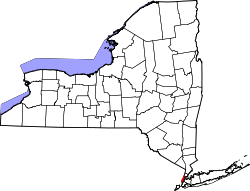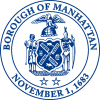
Back Manhattan Afrikaans Manhattan ALS Manhatten ANG مانهاتن Arabic مانهاتن ARZ Manhattan AST Manhetten Azerbaijani منهتن AZB Manhattan BAN Manhattan BAR
Manhattan
New York County | |
|---|---|
 Midtown Manhattan, the world's largest central business district, in the foreground, with Lower Manhattan and its Financial District in the background | |
| Etymology: Lenape: Manaháhtaan (the place where we get bows) | |
| Nickname: The City | |
 Interactive map outlining Manhattan | |
 Map of Manhattan in New York | |
Location within New York City Location within the State of New York Location within the United States Location on Earth | |
| Coordinates: 40°42′46″N 74°00′21″W / 40.7127°N 74.0059°W | |
| Country | |
| State | |
| County | New York County (coterminous) |
| City | New York City |
| Settled | 1624 |
| Government | |
| • Type | Borough (New York City) |
| • Borough President | Mark Levine (D) — (Borough of Manhattan) |
| • District Attorney | Alvin Bragg (D) — (New York County) |
| Area | |
• Total | 33.59 sq mi (87.0 km2) |
| • Land | 22.83 sq mi (59.1 km2) |
| • Water | 10.76 sq mi (27.9 km2) 32% |
| Dimensions —width at 14th Street, widest | |
| • Length | 13 mi (21 km) |
| • Width | 2.3 mi (3.7 km) |
| Highest elevation | 265 ft (81 m) |
| Population | |
• Total | 1,694,250 |
• Estimate (2022)[3] | 1,596,273 |
| • Density | 74,781.6/sq mi (28,873.3/km2) |
| Demonyms | Manhattanite[4] Knickerbocker (historical) |
| GDP | |
| • Total | $885.652 billion (2022) · 2nd by U.S. county; 1st per capita |
| Time zone | UTC−05:00 (EST) |
| • Summer (DST) | UTC−04:00 (EDT) |
| ZIP Code format | 100xx, 101xx, 102xx |
| Area code | 212/646/332, 917[a] |
| Website | Manhattan Borough President |
Manhattan (/mænˈhætən, mən-/ man-HAT-ən, mən-) is the most densely populated and geographically smallest of the five boroughs of New York City. Coextensive with New York County, Manhattan is the smallest county by geographical area in the U.S. state of New York. Located almost entirely on Manhattan Island near the southern tip of the state, Manhattan constitutes the center of the Northeast megalopolis and the urban core of the New York metropolitan area.[6] Manhattan serves as New York City's economic and administrative center and has been described as the cultural, financial, media, and entertainment capital of the world.[7][8][9][10]
Present-day Manhattan was originally part of Lenape territory.[11] European settlement began with the establishment of a trading post by Dutch colonists in 1624 on southern Manhattan Island; the post was named New Amsterdam in 1626. The territory and its surroundings came under English control in 1664 and were renamed New York after King Charles II of England granted the lands to his brother, the Duke of York.[12] New York, based in present-day Lower Manhattan, served as the capital of the United States from 1785 until 1790.[13] The Statue of Liberty in New York Harbor greeted millions of arriving immigrants in the late 19th century and is a world symbol of the United States and its ideals.[14] Manhattan became a borough during the consolidation of New York City in 1898, and houses New York City Hall, the seat of the city's government.[15] Harlem in Upper Manhattan became the center of what is now known as the cultural Harlem Renaissance in the 1920s. The Stonewall Inn in Greenwich Village, part of the Stonewall National Monument, is considered the birthplace in 1969 of the modern gay rights movement, cementing Manhattan's central role in LGBT culture.[16][17] Manhattan was the site of the original World Trade Center, which was destroyed during the September 11, 2001 terrorist attacks.
Situated on one of the world's largest natural harbors, the borough is bounded by the Hudson, East, and Harlem rivers and includes several small adjacent islands, including Roosevelt, U Thant, and Randalls and Wards Islands. It also includes the small neighborhood of Marble Hill now on the U.S. mainland. Manhattan Island is divided into three informally bounded components, each cutting across the borough's long axis: Lower Manhattan, Midtown, and Upper Manhattan. Manhattan is one of the most densely populated locations in the world, with a 2020 census population of 1,694,250 living in a land area of 22.66 square miles (58.69 km2),[3][18] or 72,918 residents per square mile (28,154 residents/km2), and coextensive with New York County, its residential property has the highest sale price per square foot in the United States.[19]
Manhattan is home to Wall Street as well as the world's two largest stock exchanges by total market capitalization, the New York Stock Exchange and Nasdaq.[20] Many multinational media conglomerates are based in Manhattan, as are numerous colleges and universities, such as Columbia University and New York University. The headquarters of the United Nations is located in the Turtle Bay neighborhood of Midtown Manhattan. Manhattan hosts three of the world's top 10 most-visited tourist attractions: Times Square, Central Park, and Grand Central Terminal.[21] Penn Station is the busiest transportation hub in the Western Hemisphere.[22] Chinatown incorporates the highest concentration of Chinese people in the Western Hemisphere.[23] Fifth Avenue is the most expensive shopping street in the world.[24] The borough hosts many prominent bridges, tunnels, and skyscrapers including the Empire State Building, Chrysler Building, and One World Trade Center.[25] It is also home to the National Basketball Association's New York Knicks and the National Hockey League's New York Rangers.
- ^ 2010 Census Gazetteer Files: New York County Subdivisions Archived June 16, 2019, at the Wayback Machine, United States Census Bureau. Accessed June 19, 2017.
- ^ Manhattan High Point
- ^ a b c Cite error: The named reference
QuickFactswas invoked but never defined (see the help page). - ^ Moynihan, Colin. "F.Y.I." Archived April 17, 2020, at the Wayback Machine, The New York Times, September 19, 1999. Accessed December 17, 2019. "There are well-known names for inhabitants of four boroughs: Manhattanites, Brooklynites, Bronxites and Staten Islanders. But what are residents of Queens called?"
- ^ "Gross Domestic Product by County and Metropolitan Area", fred.stlouisfed.org
- ^ "World Urban Areas" (PDF). Demographia. April 2018. Retrieved April 27, 2018.
- ^ "A Nation challenged: in New York; New York Carries On, but Test of Its Grit Has Just Begun" Archived March 24, 2020, at the Wayback Machine, The New York Times, October 11, 2001. Accessed November 20, 2016. "A roaring void has been created in the financial center of the world."
- ^ Sorrentino, Christopher (September 16, 2007). "When He Was Seventeen". The New York Times. Retrieved December 22, 2007.
In 1980, there were still the remains of the various downtown revolutions that had reinvigorated New York's music and art scenes and kept Manhattan in the position it had occupied since the 1940s as the cultural center of the world.
- ^ Michael P. Ventura (April 6, 2010). "Manhattan May Be the Media Capital of the World, But Not For iPad Users". DNAinfo. Archived from the original on August 4, 2017. Retrieved June 11, 2017.
- ^ Dawn Ennis (May 24, 2017). "ABC will broadcast New York's pride parade live for the first time". LGBTQ Nation. Archived from the original on July 28, 2017. Retrieved June 4, 2017.
- ^ Burrows, Edwin G.; Wallace, Mike (1998). Gotham : a history of New York City to 1898. Mike Wallace. Oxford: Oxford University Press. pp. 6–7. ISBN 978-0-585-36462-9. OCLC 47011419.
- ^ "KINGSTON Discover 300 Years of New York History DUTCH COLONIES". National Park Service, U.S. Department of the Interior. Archived from the original on November 23, 2008. Retrieved April 7, 2018.
- ^ "The Nine Capitals of the United States". United States Senate. Archived from the original on March 20, 2016. Retrieved April 7, 2018.
- ^ "Statue of Liberty". World Heritage. UNESCO World Heritage Centre 1992–2011. Archived from the original on August 28, 2012. Retrieved April 7, 2018.
- ^ Michael M. Grynbaum (May 24, 2012). "The Reporters of City Hall Return to Their Old Perch". The New York Times. Archived from the original on June 25, 2017. Retrieved December 5, 2013.
- ^ "Workforce Diversity The Stonewall Inn, National Historic Landmark National Register Number: 99000562". National Park Service, U.S. Department of the Interior. Archived from the original on March 6, 2016. Retrieved July 2, 2013.
- ^ "Obama inaugural speech references Stonewall gay-rights riots". North Jersey Media Group Inc. January 21, 2013. Archived from the original on May 30, 2013. Retrieved July 2, 2013.
- ^ "2020 Census Urban Areas Facts (2020)". United States Census Bureau. Retrieved January 12, 2024.
- ^ Cite error: The named reference
ManhattanPricePerSquareFootwas invoked but never defined (see the help page). - ^ Neufeld, Dorothy. "Mapped: The Largest Stock Exchanges in the World", Virtual Capitalist, October 18, 2023. Accessed December 26, 2023.
- ^ Ann Shields (November 10, 2014). "The World's 50 Most Visited Tourist Attractions – No. 3: Times Square, New York City – Annual Visitors: 50,000,000". Travel+Lesiure. Archived from the original on July 21, 2015. Retrieved July 12, 2015.
No. 3 Times Square, ... No. 4 (tie) Central Park, ... No. 10 Grand Central Terminal, New York City
- ^ Michael Kimmelman (September 30, 2016). "Penn Station Reborn". The New York Times. Retrieved August 3, 2022.
- ^ Sarah Waxman. "The History of New York's Chinatown". Mediabridge Infosystems, Inc. Retrieved January 12, 2024.
Manhattan's Chinatown, the largest Chinatown in the United States and the site of the largest concentration of Chinese in the Western Hemisphere, is located on the Lower East Side.
- ^ "New York's Fifth Avenue Retains its Top Ranking as the World's Most Expensive Retail Destination". Cushman & Wakefield. November 20, 2023. Retrieved July 31, 2024.
- ^ "Buildings in New York City". Council on Tall Buildings and Urban Habitat. Archived from the original on July 17, 2011. Retrieved June 8, 2011.
Cite error: There are <ref group=lower-alpha> tags or {{efn}} templates on this page, but the references will not show without a {{reflist|group=lower-alpha}} template or {{notelist}} template (see the help page).





